If you live in an area that is prone to flooding, one of the best ways to protect your home and property from damage during a storm is by using a temporary flood barrier. This type of system can be put up quickly and easily in response to a developing flood and then taken down once the threat has passed. These systems are also ideal for businesses and governments to use when the cost of installing permanent defences is prohibitive.
There are a variety of different types of temporary flood barriers available in the market, ranging from simple sandbags to more sophisticated pallet-based structures that can be deployed over a length of several hundred metres. These systems all require a substantial amount of preplanning in order to ensure that they can be deployed in time to prevent flooding. In particular, the operational resources required to operate the defence, storage facilities and the logistics of deployment need to be fully appreciated by anyone who plans to rely on these types of defences.
While many of these systems have their advantages, there are some that come with a number of disadvantages as well. For example, sandbags can become filled with debris and pose a safety risk to users. Additionally, they can be very difficult to store and are only suitable for short-term use.
Fortunately, there are now many newer technologies that can be used to reduce the impact of flooding on homes and communities. These include removable flood barriers that can be stored in a garage or a shed when not in use, and even reroute water flows away from the property. In addition, there are now a range of innovative, automated devices that can be installed in front of the entrance door of a house to hermetically seal it and block the flow of water from entering the building.
One such device is the Inero flood barrier, which can be positioned in front of an entrance door and can be activated by either a Karman sensor mounted on the lintel or through a smartphone app. The sensor will activate the pneumatic pump connected to the barrier when it detects a change in ambient pressure. Once the air is in the highest position, it will switch off to avoid rupture of the chamber.
Another option is the Maccaferri FlexMac temporary flood protection barrier, which can be raised by either mechanical means or people. The system is filled with locally available materials such as sand and general fill to form an effective barrier that can be lowered into place in the event of a flood.
While this system has its supporters, it has also been criticised for interfering with the lagoon ecosystem and turning it into a mere pond. In addition, some have argued that it is not possible to raise the system as quickly and efficiently as a cofferdam. However, the system is being defended on the grounds that it provides a viable and safe alternative to traditional flood defences and is significantly cheaper than repairing and replacing damaged property.

